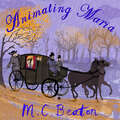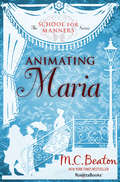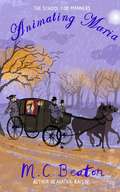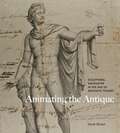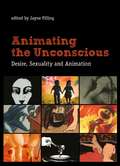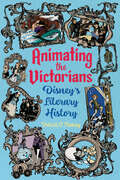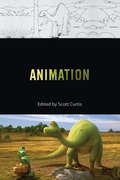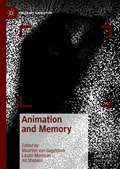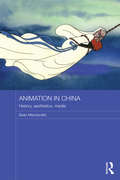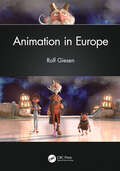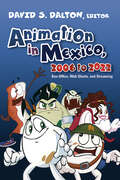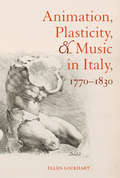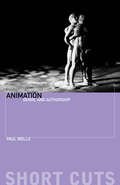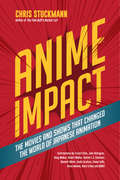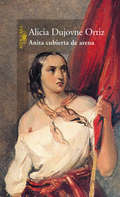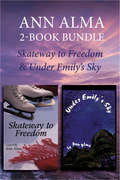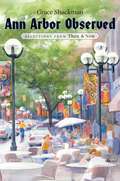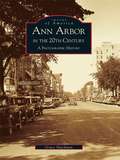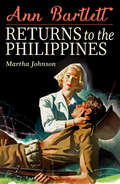- Table View
- List View
Animating Maria (School for Manners #5)
by M.C. Beaton'If you have a Wild, Unruly, or Undisciplined Daugher, two Ladies of Genteel Birth offer to Bring Out said Daughter and Refine what may have seemed Unrefinable. We can make the Best of the Worst'When Amy and Effie Tribble, two charming but impoverished spinster sisters, lose out on an inheritance, they place this advertisement in The Morning Post and hire themselves out as professional chaperones. Vowing to prepare even the most difficult misses for marriage, the Tribble sisters will spend a London season on each client, educating them in their School for Manners.Maria Kendall is seemingly a dream client - beautiful, impeccably mannered, effortlessly graceful and extremely well dowered. In short, she doesn't seem to need the Tribbles' help at all. But then the sisters meet her parents and realise that they do have a problem on their hands - not with the perfect Maria, but with her overweening, gauche and socially over-ambitious parents!
Animating Maria (The School for Manners Series #5)
by M. C. BeatonIn this Regency romance by the New York Times–bestselling author of the Agatha Raisin mysteries, a young lady&’s parents hinder her chances at marriage.Amy and Effy Tribble can't believe their luck. After four seasons spent molding intractable, wayward, or just plain frumpy young women into marriage material, their fifth Season in the chaperone business brings them a dream client. Maria Kendall, is beautiful, impeccably mannered, effortlessly graceful, and extremely well-dowered. She is a perfect candidate for marriage, even if none of her real suitors—especially the proud and aristocratic Duke of Berham—quite live up to her dreams. But when the Duke meets Maria&’s vulgar and boorish parents his proposal is quickly withdrawn. Amy and Effy soon realize that they face their greatest challenge yet—taking on not only Maria, but the hopelessly common Kendalls as well. ABOUT THE SERIES The Misses Tribble, Amy and Effie, spinster sisters of a certain age, have lived for years on expectations of a great inheritance. When this fails to materialize, they are truly destitute. Desperate, they advertise that they will refine wild and unruly daughters, present them, and see them safely wed. The School for Manners six book series follows these two stalwart spinsters as they undertake enterprises of matchmaking and navigate the troublesome machinations of the London marriage mart.&“Another welcome return for the oddball spinster sisters…who grow more charming with every outing…. A deservedly popular series that gets only better.&”—Kirkus Reviews
Animating Maria: A Novel Of Regency England - Being The Fifth Volume Of The School For Manners (School for Manners #5)
by M.C. Beaton'If you have a Wild, Unruly, or Undisciplined Daugher, two Ladies of Genteel Birth offer to Bring Out said Daughter and Refine what may have seemed Unrefinable. We can make the Best of the Worst'When Amy and Effie Tribble, two charming but impoverished spinster sisters, lose out on an inheritance, they place this advertisement in The Morning Post and hire themselves out as professional chaperones. Vowing to prepare even the most difficult misses for marriage, the Tribble sisters will spend a London season on each client, educating them in their School for Manners.Maria Kendall is seemingly a dream client - beautiful, impeccably mannered, effortlessly graceful and extremely well dowered. In short, she doesn't seem to need the Tribbles' help at all. But then the sisters meet her parents and realise that they do have a problem on their hands - not with the perfect Maria, but with her overweening, gauche and socially over-ambitious parents!
Animating the Antique: Sculptural Encounter in the Age of Aesthetic Theory
by Sarah BetzerFramed by tensions between figural sculpture experienced in the round and its translation into two-dimensional representations, Animating the Antique explores enthralling episodes in a history of artistic and aesthetic encounters. Moving across varied locations—among them Rome, Florence, Naples, London, Dresden, and Paris—Sarah Betzer explores a history that has yet to be written: that of the Janus-faced nature of interactions with the antique by which sculptures and beholders alike were caught between the promise of animation and the threat of mortification.Examining the traces of affective and transformative sculptural encounters, the book takes off from the decades marked by the archaeological, art-historical, and art-philosophical developments of the mid-eighteenth century and culminantes in fin de siècle anthropological, psychological, and empathic frameworks. It turns on two fundamental and interconnected arguments: that an eighteenth-century ontology of ancient sculpture continued to inform encounters with the antique well into the nineteenth century, and that by attending to the enduring power of this model, we can newly appreciate the distinctively modern terms of antique sculpture’s allure. As Betzer shows, these eighteenth-century developments had far-reaching ramifications for the making and beholding of modern art, the articulations of art theory, the writing of art history, and a significantly queer Nachleben of the antique.Bold and wide-ranging, Animating the Antique sheds light upon the work of myriad artists, in addition to that of writers ranging from Goethe and Winckelmann to Hegel, Walter Pater, and Vernon Lee. It will be especially welcomed by scholars and students working in eighteenth- and nineteenth-century art history, art writing, and art historiography.
Animating the Unconscious: Desire, Sexuality and Animation
by Jayne PillingDetailed analysis of both the process and practice of key contemporary filmmakers, while also raising more general issues around the specificities of animation.
Animating the Unconscious: Desire, Sexuality, and Animation
by Ed. Jayne PillingAs critical interest has grown in the unique ways in which art animation explores and depicts subjective experience – particularly in relation to desire, sexuality, social constructions of gender, confessional modes, fantasy, and the animated documentary – this volume offers detailed analysis of both the process and practice of key contemporary filmmakers, while also raising more general issues around the specificities of animation. Combining critical essays with interview material, visual mapping of the creative process, consideration of the neglected issue of how the use of sound differs from that of conventional live-action, and filmmakers' critiques of each others' work, this unique collection aims to both provoke and illuminate via an insightful multi-faceted approach.
Animating the Victorians: Disney's Literary History (Children's Literature Association Series)
by Patrick C. FlemingMany Disney films adapt works from the Victorian period, which is often called the Golden Age of children’s literature. Animating the Victorians: Disney’s Literary History explores Disney’s adaptations of Victorian texts like Alice in Wonderland, Oliver Twist, Treasure Island, Peter Pan, and the tales of Hans Christian Andersen. Author Patrick C. Fleming traces those adaptations from initial concept to theatrical release and beyond to the sequels, consumer products, and theme park attractions that make up a Disney franchise. During the production process, which often extended over decades, Disney’s writers engaged not just with the texts themselves but with the contexts in which they were written, their authors’ biographies, and intervening adaptations. To reveal that process, Fleming draws on preproduction reports, press releases, and unfinished drafts, including materials in the Walt Disney Company Archives, some of which have not yet been discussed in print. But the relationship between Disney and the Victorians goes beyond adaptations. Walt Disney himself had a similar career to the Victorian author-entrepreneur Charles Dickens. Linking the Disney Princess franchise to Victorian ideologies shows how gender and sexuality are constantly being renegotiated. Disney’s animated musicals, theme parks, copyright practices, and even marketing campaigns depend on cultural assumptions, legal frameworks, and media technologies that emerged in nineteenth-century England. Moreover, Disney’s adaptations influence modern students and scholars of the Victorian period. By applying scholarship in Victorian studies to a global company, Fleming shows how institutions mediate our understanding of the past and demonstrates the continued relevance of literary studies in a corporate media age.
Animation (Behind the Silver Screen Series)
by Andrew Johnston Susan Ohmer Bob Rehak Kevin Sandler Alla GadassikFrom the earliest motion pictures and cartoons of the 1900s, to the latest 3D animated feature and CGI blockbuster, animation has always been a part of the cinematic experience. While the boundaries between animation and live-action have often been carefully tended, the ubiquity of contemporary computer imaging certainly blurs those lines, thereby confirming the importance of animation for the history of American cinema. The last installment of the acclaimed Behind the Silver Screen series, Animation explores the variety of technologies and modes of production throughout the history of American animation: the artisanal, solitary labors of early animators such as Winsor McCay, or of independent animators such as Mary Ellen Bute; the industrial assembly lines of Hollywood studio-unit animation; the parsimonious production houses of the post-studio, post-war era; the collaborative approach of boutique animation and special-effect houses. Drawing on archival sources, this volume provides not only an overview of American animation history, but also, by focusing on the relationship between production and style, a unique approach to understanding animation in general.
Animation Development: From Pitch to Production
by David B. LevyWhether a novice curious about the cartoon production process, a visual arts student who has not yet experienced that big break, or a seasoned professional looking for valuable insight, Animation Development is the go-to guide for creating the perfect pitch. David Levy has been through every aspect of the pitching process--preparation, hope, rejection, success- and now he wraps up his valuable experience to deliver this comprehensive guide on the industry and process. Animation Development will help readers discover how to tap into their creativity to develop something personal yet universal, push projects through collaborations and partnerships, set up pitch meetings, get legal representation and agents, and manage the emotional roller-coaster common to the pitching and development process.
Animation and Memory (Palgrave Animation)
by László Munteán Maarten Van Gageldonk Ali ShobeiriThis book examines the role of memory in animation, as well as the ways in which the medium of animation can function as a technology of remembering and forgetting. By doing so, it establishes a platform for the cross-fertilization between the burgeoning fields of animation studies and memory studies. By analyzing a wide range of different animation types, from stop motion to computer animation, and from cell animated cartoons to painted animation, this book explores the ways in which animation can function as a representational medium. The five parts of the book discuss the interrelation of animation and memory through the lens of materiality, corporeality, animation techniques, the city, and animated documentaries. These discussions raise a number of questions: how do animation films bring forth personal and collective pasts? What is the role of found footage, objects, and sound in the material and affective dimensions of animation? How does animation serve political ends? The essays in this volume offer answers to these questions through a wide variety of case studies and contexts. The book will appeal to both a broad academic and a more general readership with an interest in animation studies, memory studies, cultural studies, comparative visual arts, and media studies.
Animation in China: History, Aesthetics, Media (Routledge Contemporary China Series)
by Sean MacdonaldBy the turn of the 21st century, animation production has grown to thousands of hours a year in the People’s Republic of China (PRC). Despite this, and unlike American blockbuster productions and the diverse genres of Japanese anime, much animation from the PRC remains relatively unknown. This book is an historical and theoretical study of animation in the PRC. Although the Wan Brothers produced the first feature length animated film in 1941, the industry as we know it today truly began in the 1950s at the Shanghai Animation Film Studio (SAFS), which remained the sole animation studio until the 1980s. Considering animation in China as a convergence of the institutions of education, fine arts, literature, popular culture, and film, the book takes comparative approaches that link SAFS animation to contemporary cultural production including American and Japanese animation, Pop Art, and mass media theory. Through readings of classic films such as Princess Iron Fan, Uproar in Heaven, Princess Peacock, and Nezha Conquers the Dragon King, this study represents a revisionist history of animation in the PRC as a form of "postmodernism with Chinese characteristics." As a theoretical exploration of animation in the People’s Republic of China, this book will appeal greatly to students and scholars of animation, film studies, Chinese studies, cultural studies, political and cultural theory.
Animation in Europe
by Rolf GiesenThere is a lot one could say about animation in Europe, but above all, there is no consistent European animation. It is as disparate as the various countries involved. Audiences will certainly recognize American or Japanese animation, but in Europe, it can range from Czech, Polish, and Hungarian to Greek, Italian, Spanish, Portuguese, French, and British. Animation in Europe provides a comprehensive review of the history and current situation of animation in over 20 European countries. It features numerous interviews with artists and producers, including rare documents and firsthand accounts that illustrate the rich history of animation in Europe. Additional features include • An extensive chronology with key events in European animation • A Who’s Who of producers, directors, writers, and animators working in Europe • An examination of the origin of European animation and its influence Animation in Europe is the first book devoted entirely to this topic and, therefore, will be of value for animation buffs as well as practitioners and researchers.
Animation in Mexico, 2006 to 2022: Box Office, Web Shorts, and Streaming (SUNY series in Latin American Cinema)
by David S. DaltonExamines contemporary animation in Mexico—one of the most commercially successful and most understudied genres of the national cinema.Answering a call to view Mexican film through the lens of commercial cinema, Animation in Mexico, 2006 to 2022 is the first book-length study of the country's animated cinema in the twenty-first century. As such, the volume sheds light on one of the country's most strategically important and lucrative genres, subjecting it to sustained intellectual analysis for the first time. Building on earlier film history, David S. Dalton identifies two major periods, during which the focus shifted from success at the national box office to internationalization and streaming. In eight original essays, contributors use an array of theoretical and disciplinary approaches to interrogate how this popular genre interfaces with Mexican politics and society more broadly, from Huevocartoon to Coco and beyond. The book will appeal to students, scholars, and fans of Mexican film by situating animation within broader currents in the field and the industry.
Animation, Plasticity, and Music in Italy, 1770-1830
by Ellen LockhartThis path-breaking study of stage works in Italian musical performances reconsiders a crucial period of music history. Through an interdisciplinary examination of the statue animated by music, Ellen Lockhart deftly shows how Enlightenment ideas influenced Italian theater and music, and vice versa. As Lockhart reveals, the animated statue became a fundamental figure within aesthetic theory and musical practice during the years spanning 1770–1830. Taking as its point of departure a repertoire of Italian ballets, melodramas, and operas from this period, Animation, Plasticity, and Music in Italy traces its core ideas between science, philosophy, theories of language, itinerant performance traditions, the epistemology of sensing, and music criticism.
Animation: Genre and Authorship (Short Cuts)
by Paul WellsAnimation: Genre and Authorship explores the distinctive language of animation, its production processes, and the particular questions about who makes it, under what conditions, and with what purpose. In this first study to look specifically at the ways in which animation displays unique models of ‘auteurism’ and how it revises generic categories, Paul Wells challenges the prominence of live-action moviemaking as the first form of contemporary cinema and visual culture. The book also includes interviews with Ray Harryhausen and Caroline Leaf, and a full timeline of the history of animation.
Anime Impact: The Movies and Shows that Changed the World of Japanese Animation
by Chris StuckmannAn exploration of anime’s masterpieces and game-changers from the 1960s to the present—with contributions from writers, artists, superfans and more.Anime—or Japanese animation—has been popular in Japan since Astro Boy appeared in 1963. Subsequent titles like Speed Racer and Kimba the White Lion helped spread the fandom across the country. In America, a dedicated underground fandom grew through the 80s and 90s, with breakthrough titles like Katsuhiro Otomo’s Akira making their way into the mainstream.Anime Impact explores the iconic anime movies and shows that left a mark on popular culture around the world. Film critic and longtime fan Chris Stuckmann takes readers behind the scenes of legendary titles as well as hidden gems rarely seen outside Japan. Plus anime creators, critics and enthusiasts—including Ready Player One author Ernest Cline, manga artist Mark Crilley, and YouTube star Tristan “Arkada” Gallant—share their stories, insights and insider perspectives.
Anime's Identity: Performativity and Form beyond Japan
by Stevie SuanA formal approach to anime rethinks globalization and transnationality under neoliberalism Anime has become synonymous with Japanese culture, but its global reach raises a perplexing question—what happens when anime is produced outside of Japan? Who actually makes anime, and how can this help us rethink notions of cultural production? In Anime&’s Identity, Stevie Suan examines how anime&’s recognizable media-form—no matter where it is produced—reflects the problematics of globalization. The result is an incisive look at not only anime but also the tensions of transnationality.Far from valorizing the individualistic &“originality&” so often touted in national creative industries, anime reveals an alternate type of creativity based in repetition and variation. In exploring this alternative creativity and its accompanying aesthetics, Suan examines anime from fresh angles, including considerations of how anime operates like a brand of media, the intricacies of anime production occurring across national borders, inquiries into the selfhood involved in anime&’s character acting, and analyses of various anime works that present differing modes of transnationality. Anime&’s Identity deftly merges theories from media studies and performance studies, introducing innovative formal concepts that connect anime to questions of dislocation on a global scale, creating a transformative new lens for analyzing popular media.
Anita cubierta de arena
by Alicia Dujovne OrtizLa historia de amor entre Garibaldi y Anita. La novela narra la historia de amor de Garibaldi y Anita, que Alicia Dujovne Ortiz, maestra en el arte contar, pinta, teje, canta con un placer contagioso, casi hipnótico, que atrapa al lector y lo mantiene preso de la lectura pero libre para seguir al personaje por la ciudad de Laguna, las playas de Rio Grande do Sul, a bordo del Rio Pardo, a caballo por el planalto y por el mato brasileños, en las aguas negras del río Pelotas, a través de la Serra das Antas, en la ciudad de Montevideo y cruzando el Atlántico rumbo a Italia hasta llegar a Roma en busca de la guerra y encontrar la muerte. Anita, la que sabe disparar el fusil y el cañón, la que lava su blusa y la camisa de su amante, la que domina el caballo como ninguna, la guerrillera, la puérpera que lleva en sus brazos un hijo y un arma, la carneadora de vacas, la que se encuentra enjaulada sin guerra y sin hombre, la enfermera en Roma y, finalmente, el cadáver semienterrado en una playa italiana es evocada en este magnífico relato donde se juntan la historia, la aventura y la pasión. La crítica ha dicho... «El trabajo de Dujovne Ortiz cumple holgadamente aquello del témpano de Hemingway: hay una enorme investigación histórica que sustenta lo que se ve desde lo invisible.» Ángel Berlanga, Página 12 «Dujovne Ortiz aprovechó hasta el último sudor de la aventura, romance y epopeya condensados en esta historia para hacer revivir al célebre personaje: esa mujer menuda e indómita, de cabellos retintos y mirada primitiva que a los 18 años se unió a los farrapos , los revolucionarios secesionistas que se alzaron en armas contra el emperador Pedro I, y lucharon para que Rio Grande do Sul se erigiera en Estado independiente.» Loreley Gaffoglio, ADN Cultura
Anjo de Fogo
by Tanya Anne Crosby Elaine MoreiraDespedaçada pela morte do pai na batalha de Tinchebray, a nobre normanda Chrestien de Lontaine planeja casar a irmã e depois buscar a proteção de um convento, jurando não pertencer a homem nenhum... Pelo menos dessa vez, Chrestien está profundamente feliz por seu pai ter sido tão protetor, pois poucos sabiam que ele possuía filhas gêmeas. Mas alguém sabe de seu segredo... e agora só o Lobo Prateado de Henrique, o odiado inimigo responsável pela morte de seu pai, pode salvar essa impetuosa beldade.
Anjo negro: O legado de Russe
by Kathryn Le Veque1356 d.c. - São tempos de guerra para a Inglaterra, quando o príncipe negro percorre a França, travando uma guerra desagradável contra a população. O idealizador dessa estratégia brutal é o cavaleiro que eles chamam de Anjo Negro. Brandt de Russe, duque de Exeter, é o cérebro por trás da máquina de guerra do príncipe, um montanha de homem que é tão astuto quanto assustador. Na batalha, nenhum homem é igual a ele. Lady Ellowyn de Nerra, neta do grande mercenário Braxton de Nerra, foi enviada a Londres por seu pai aleijado para recolher os homens que ele doou para as guerras do príncipe negro na França. Os homens de De Nerra se misturam com os homens do duque de Exeter e Ellowyn está nas docas quando o duque desembarca seus navios. Na tentativa de se apresentar a Brandt e explicar seu propósito, o duque tem pouco tempo para a bela jovem e a confunde com uma prostituta. Insultada, Ellowyn ameaça o homem que todos os homens temem. E assim começa a história de amor ardente, apaixonada e profunda que transcende famílias, reis e dois continentes, construindo a Batalha de Poitiers, onde Brandt está na linha de frente. Na batalha, nenhum homem é igual a ele, mas mesmo os homens mais poderosos são prisioneiros de seus próprios corações.
Ann Alma Children's Library 2-Book Bundle: Skateway to Freedom / Under Emily's Sky
by Ann AlmaCritically acclaimed children's author Ann Alma presents two beloved books for young people, gathered together in this special bundle. Shortlisted for the Forest of Reading Silver Birch Award Includes: Under Emily’s Sky During a camping trip, 11-year-old Lee finds herself on a rough trail in a Vancouver Island forest. Halfway to an abandoned homestead, Lee trips and is knocked unconscious. She awakens in a strange world: all the usual landmarks have disappeared and the terrain is unpopulated except for a strange trailer and a herd of dogs. Lee investigates only to find an ornery woman at an easel who says she's named Emily Carr, and a family from the Depression-torn Prairies illegally logging the island's mighty cedars. Skateway to Freedom Eleven-year-old Josie Grun escapes from Communist East Germany with her mother and father one dark night in 1989 just months before the Berlin Wall comes tumbling down. Braving border guards, barbed wire, and rifle shots, Josie reluctantly turns her back on her best friend, Greta, and all that was once familiar. She crosses the ocean to join her uncle in Calgary, attempts to learn a foreign language, and overcomes the prejudices of her schoolmates in order to forge a new life. Clinging to the passion that has always been a comfort, her figure skating, she enters a local competition to prove that she is free on the ice and off.
Ann Arbor Beer: A Hoppy History of Tree Town Brewing (American Palate)
by David BardallisAnn Arbor has always been a beer-loving town. From the establishment of the first commercial brewery in 1838 through a century of German immigration down to today's local craft brew boom, the amber liquid looms large in Tree Town's quirky past and present. Find out how beer helped a former University of Michigan professor win a Nobel Prize. Discover the Ann Arbor doctor whose nationally bestselling home remedy book featured ale recipes. Learn which Michigan football legend pounded brewskis as part of his training regimen. Covering the exploits of famous poets, performers and prohibitionists, local author David Bardallis pops the cap off the big beer history of this little college town and leads readers to "the best beer you can drink" in Ann Arbor today.
Ann Arbor Observed: Selections from Then and Now
by Grace ShackmanTwenty-five years ago Grace Shackman began to document the history of Ann Arbor’s buildings, events, and people in theAnn Arbor Observer. Soon Shackman’s articles, which depicted every aspect of life in Ann Arbor during the city’s earlier eras, became much-anticipated regular stories. Readers turned to her illuminating minihistories when they wanted to know about a particular landmark, structure, personality, organization, or business from Ann Arbor’s past. Packed with photographs from Ann Arbor of yesteryear and the present day,Ann Arbor Observedcompiles the best of Shackman’s articles in one book divided into eight sections: public buildings and institutions, the University of Michigan, transportation, industry, downtown Ann Arbor, recreation and culture, social fabric and communities, and architecture. For long-time residents, Ann Arbor expatriates, University of Michigan alumni, and visitors alike,Ann Arbor Observedprovides a rare glimpse of the bygone days of a town with a rich and varied history. Grace Shackman is a history columnist for theAnn Arbor Observer,theCommunity Observer,and theOld West Side News,as well as a writer for University of Michigan publications. She is the author of two previous books:Ann Arbor in the 19th CenturyandAnn Arbor in the 20th Century.
Ann Arbor in the 19th Century: A Photographic History
by Grace ShackmanAnn Arbor has never been a typical college town, typical industrial town, or typical agricultural center. The city was founded in 1824 by John Allen and Elisha Rumsey. Settlers from the Eastern U.S. of British origin were soon followed by Germans, who brought with them many practical skills. With the opening of the University of Michigan campus in 1841, still more people came from across the country to teach and learn. Ann Arbor in the 19th Century: A Photographic History, details the growth of the city, when residents built houses and businesses, organized a government, and established churches, schools, a university, and newspapers, in over 190 photographs. Early residents would recognize the photograph of Okemos, nephew of Pontiac, Chief of the Ottawa, who made regular visits to Ann Arbor, before the Native Americans were banished to Kansas by the federal government. Another fascinating photo shows Henry Otto's Band, whose family was responsible for much of the music at official events. However, much of 19th century Ann Arbor would still be recognizable to today's residents.
Ann Bartlett Returns to the Philippines
by Martha JohnsonAnn Bartlett Returns to the Philippines, first published in 1945, is an exciting historical-fiction novel centering on Navy nurse Ann Bartlett and her friend and fellow nurse Evelyn Baldwin; location: the occupied Philippines during World War II. The pair travel from the U.S. to the Philippines and serve as nurses aboard a ship. Upon reaching the Philippines, their adventures begin as Ann boards a lifeboat searching for survivors of a nearby ship that has gone down following a Japanese attack; foggy weather separates the lifeboat from the ship, and when the weather clears, a Japanese airplane machine-guns the boat, forcing the passengers into the water. The story continues with the survivors reaching an island shore, narrow escapes from the Japanese, and a romance. Five ‘Ann Bartlett’ books were published by author Martha Johnson between 1941-1946.
